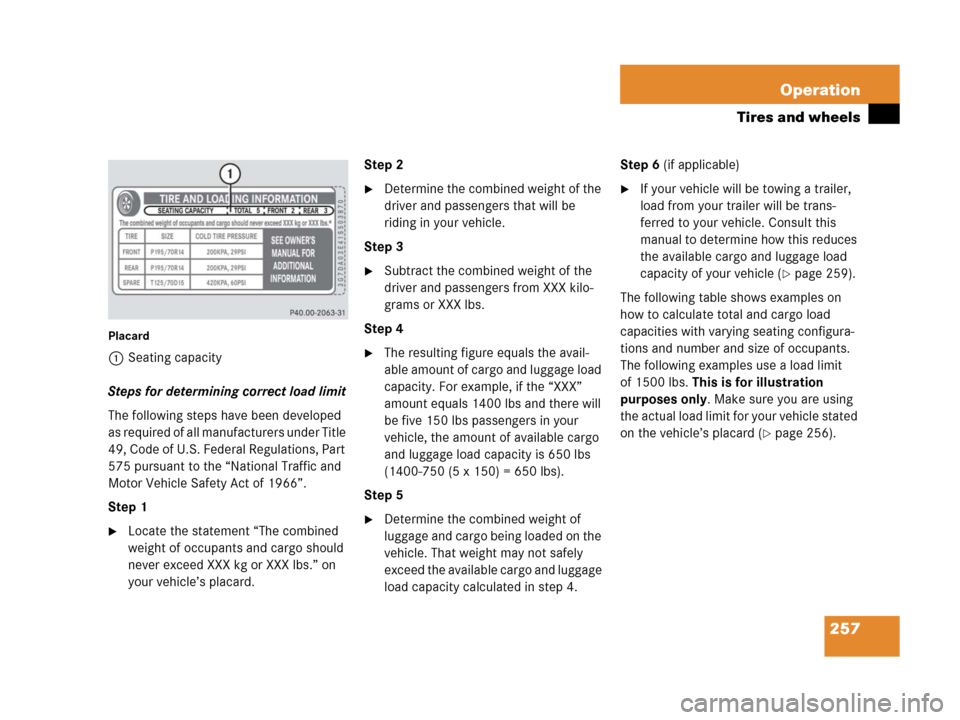Page 258 of 417

257 Operation
Tires and wheels
Placard
1Seating capacity
Steps for determining correct load limit
The following steps have been developed
as required of all manufacturers under Title
49, Code of U.S. Federal Regulations, Part
575 pursuant to the “National Traffic and
Motor Vehicle Safety Act of 1966”.
Step 1
�Locate the statement “The combined
weight of occupants and cargo should
never exceed XXX kg or XXX lbs.” on
your vehicle’s placard.Step 2
�Determine the combined weight of the
driver and passengers that will be
riding in your vehicle.
Step 3
�Subtract the combined weight of the
driver and passengers from XXX kilo-
grams or XXX lbs.
Step 4
�The resulting figure equals the avail-
able amount of cargo and luggage load
capacity. For example, if the “XXX”
amount equals 1400 lbs and there will
be five 150 lbs passengers in your
vehicle, the amount of available cargo
and luggage load capacity is 650 lbs
(1400-750 (5 x 150) = 650 lbs).
Step 5
�Determine the combined weight of
luggage and cargo being loaded on the
vehicle. That weight may not safely
exceed the available cargo and luggage
load capacity calculated in step 4.Step 6 (if applicable)
�If your vehicle will be towing a trailer,
load from your trailer will be trans-
ferred to your vehicle. Consult this
manual to determine how this reduces
the available cargo and luggage load
capacity of your vehicle (
�page 259).
The following table shows examples on
how to calculate total and cargo load
capacities with varying seating configura-
tions and number and size of occupants.
The following examples use a load limit
of 1500 lbs. This is for illustration
purposes only. Make sure you are using
the actual load limit for your vehicle stated
on the vehicle’s placard (
�page 256).
Page 260 of 417

259 Operation
Tires and wheels
Certification label
Even after careful determination of the
combined weight of all occupants, cargo
and the trailer tongue load (if applicable)
(
�page 259) as to not exceed the permis-
sible load limit, you must make sure that
your vehicle never exceeds the Gross
Vehicle Weight Rating (GVWR) and the
Gross Axle Weight Rating (GAWR) for ei-
ther the front or rear axle. You can obtain
the GVWR and GAWR from the
Certification label. The Certification label
can be found on the driver’s door B-pillar
(
�page 255).Gross Vehicle Weight Rating (GVWR): The
total weight of the vehicle, all occupants,
all cargo, and the trailer tongue load
(
�page 259) must never exceed the
GVWR.
Gross Axle Weight Rating (GAWR): The
total allowable weight that can be carried
by a single axle (front or rear).
To assure that your vehicle does not ex-
ceed the maximum permissible weight
limits (GVWR and GAWR for front and rear
axle), have the loaded vehicle (including
driver, passengers and all cargo and, if ap-
plicable, trailer fully loaded) weighed on a
suitable commercial scale.Trailer tongue load
The tongue load of any trailer is an impor-
tant weight to measure because it affects
the load you can carry in your vehicle. If a
trailer is towed, the tongue load must be
added to the weight of all occupants riding
and any cargo you are carrying in the
vehicle. The tongue load typically is ten
percent of the trailer weight and every-
thing loaded in it.
If an approved Mercedes-Benz trailer hitch
is available for your G-Class vehicle model,
consult the instructions included in the
trailer hitch kit for vehicle towing capacity,
permissible gross trailer weight, trailer
tongue weight rating, and instructions on
loading and towing a trailer.
Page 397 of 417

396 Index
Engine oil level see Oil level
Enlarged cargo compartment 188
ESP 25, 80, 84, 384
Messages in display 302
Switching off 86
Switching on 87
Synchronizing 302
Warning lamp 295
ETD 62, 71, 384
Safety guidelines 66
Exterior lamp switch 110
Exterior lamps
Delayed shut-off 140
Exterior rear view mirrors
Adjusting 41
Parking position for 144
F
Fahrenheit
Setting temperature units 136
Fastening the seat belts 43
Fine adjustment
Cruise control 183
First aid kit 323Flat tire 348
Lowering the vehicle 352
Mounting the spare wheel 349
Spare wheel 325
Flexible Service System (FSS, Canada
vehicles) 384
Fog lamp, rear 114, 336
Fog lamps, front 113
Messages in display 315
4-ETS 80, 83
Front airbags 67
Front axle differential lock
Switching on 162
Front fog lamps
Replacing bulbs 336, 340
Front lamps
Messages in display 314, 316
Replacing bulbs 336, 338
Switching on 110
Front seat head restraints
Installing 102
Removing 101
Front towing eye 361
Front turn signal lamp
Replacing bulbs 342FSS (Flexible Service System, Canada
vehicles) 384
Fuel 240
Additives 379
Fuel reserve warning lamp 296
Gasoline additives 379
Premium unleaded gasoline 240,
376, 378
Refueling 239
Requirements 379
Reserve warning 25
Technical data 376
Fuel additives 379
Fuel consumption statistics
After start 145
Since last reset 145
Fuel filler flap 239
Locking 239
Opening 328
Unlocking 239
Fuel requirements 379
Fuel reserve tank
Message in display 313
Fuel tank
Capacity 376
Filler flap 239
Page 412 of 417

411 Index
V
Vehicle
Data recording 20
Individual settings 132, 135
Locking 28
Locking in an emergency 328
Lowering 352
Service battery 353
Towing 358
Unlocking 28
Unlocking in an emergency 327
Vehicle battery 353
Vehicle capacity weight 276
Vehicle care 283
Cup holders 287
Engine cleaning 285
Gear selector lever 287
Hard plastic trim items 287
Headlamps 285
Instrument cluster 287
Leather upholstery 288
Light alloy wheels 287
MB Tex upholstery 288
Ornamental moldings 285
Paintwork 284
Plastic and rubber parts 288Power washer 284
Seat belts 287
Side markers 285
Steering wheel 287
Tail lamps 285
Tar stains 284
Turn signals 285
Vehicle washing 285
Window cleaning 286
Wiper blades 286
Wood trims 288
Vehicle data recording 20
Vehicle identification number (VIN) 368
Vehicle jack 324
Vehicle loading terminology 273
Vehicle maximum load on the tire 276
Vehicle status message memory 131
Calling up 131
Clearing 131
Vehicle tool kit 323
Vehicle washing 285
VIN (Vehicle Identification Number) 368,
388
Voice control system* 388W
Warning indicators
Rear Parking Assist* 186
Warning sounds
Drivers seat belts 68
Exterior lighting 111
Maintenance service indicator 281
Parking brake 50
Warranty coverage 367
Washer fluid see Windshield washer fluid
Washing the vehicle 284
Wear pattern (tires) 277
Weights and ratings 375
Wheel change
Tightening torque 352
Wheels
Tires and wheels 252
Window curtain airbags 68
Windows see Side windows
Windshield
Defogging 171
Replacing wiper blades 346
Washer fluid 249, 382
Washer system 382